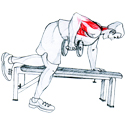-

|
-

|
| Step 1 |
Step 2 |
- Target ed Muscles:
- Back (latissimus dorsi, rhomboids & upper trapezius)
- Additional Muscles:
- Rear shoulders (posterior deltoids)
- Biceps
- You can rotate your wrist as you perform the exercise, which helps work your back muscles more. Start with your palms facing backward. As you raise the dumbbell, rotate your wrist so that your palm ends up facing your body. You may find it helpful to visualize yourself starting a lawn mower as you perform this exercise.
- To perform a variation of the one arm dumbbell row using the cable machine position a cable on a tower of a cable machine at the lowest setting and attach a handle to the cable. Stand one foot in front and slightly to the side of the tower with your feet shoulder width apart and your knees slightly bent. Then bend from the hips to position your upper body at a 45-degree angle with the floor. Grip the handle so your arm is extended in front of you and your palm is facing the floor. As you perform the exercise, use the same arm movement, except turn your wrist so your palm ends up facing your body. Perform a full set on one side and then repeat on your other side.
- The one arm row works your back, with a secondary emphasis on the back of your shoulders and your biceps. This exercise is useful if you want to add mass and definition to the muscles in your back.
- You may have a tendency to focus on the movement of your arm in this exercise. Remember, however, that this is primarily a back exercise, so you should concentrate on using your back muscles to lift the weigh.
- With proper focus on your back, this exercise can strengthen each side of your back to correct any imbalances in your back muscles. To maintain proper form, you should keep your abdominals tight and your back straight and parallel to the floor at all times.
- You will know that you are lifting the correct amount of weight if you can squeeze your shoulder blase when you pull your elbow back. You should not have to twist your body or jerk or swing the dumbbell forward to lift the weight. Use caution performing this exercise if you have shoulder, neck or lower back problems.
- Do not arch or hunch your back. Keep your back straight and parallel with the floor at all times.
- Do not twist your body or swing your dumbbell forward to help you lift the weight.
- Do not bend your neck. Keep your head, neck and back in a straight line.
- Do not lock the knee of the leg you are standing on or the elbow of the arm supporting your body.
|











